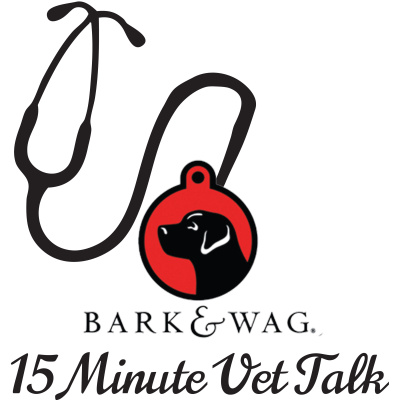Sinopsis
Each week Bark & Wag will interview Veterinarians and individuals in the pet industry from across the nation answering your questions about your pet. Visit barknwag.com/podcast to ask questions and view past podcasts.
Episodios
-
Cindy Myers, Animal Intuitive, has a virtual pet sitter business available to you over the holidays!
21/10/2018 Duración: 08minI’m Cindy Myers, Animal Listener I would like to share a little about what I do and how I got here working with both animals and two-leggers (humans...you will understand that terminology in a few minutes;) One of the frequently asked questions I get from my clients and workshop attendees is if I have always been able to communicate intuitively with animals and have empathic energy skills. The answer to that question is no, not really. I’ve always loved animals, but I was not aware of having any intuitive senses or that I could do healing energy work until I was an adult. I’ve always been a good listener. But, if twenty years ago, someone told me I’d be living on a farm with about 30 alpacas, 3 dogs, and 2 barn cats working as an intuitive energy healer and animal communicator, I would have laughed and thought that was the craziest thing I ever heard! Why I call myself An Animal Listener... Communication entails two elements; talking and listening. It has been my experience that when you
-
Dr. Laura Brown discusses why it is so important to take care of your dog's mouth and teeth.
14/10/2018 Duración: 12minPets have been an important part of our lives for many years. You can extend your pets good health and quality years with simple dental care. Dental disease is the most common problem seen in our pet population today. More than 85% of all dogs and cats presented to veterinarians are affected by dental problems. Periodontal disease is what causes bad breath, mouth pain and eventual tooth loss. We recommend daily dental care at home for your pets, just like the rest of the family. It is best to begin home care at an early age, but it is never too late. Visible tartar should be removed ultrasonically in a process known as scaling and polishing, just like when people go to the dentist. This makes your home care efforts easier and more effective. Always remember to make it FUN. Gathering Supplies: Washcloth, toothbrush or finger brush Pet toothpaste (We have products available in our hospital) Step one: Slowly acquainting your pet with mouth care (this can be started as soon as you get your puppy. Using your hand,
-
Cindy Myers, Animal Intuitive, discusses her webinar happening tonight and October 17th
03/10/2018 Duración: 06minMake sure to sign up for the webinar tonight - http://www.beananimallistener.com/events/ I’m Cindy Myers, Animal Listener I would like to share a little about what I do and how I got here working with both animals and two-leggers (humans...you will understand that terminology in a few minutes;) One of the frequently asked questions I get from my clients and workshop attendees is if I have always been able to communicate intuitively with animals and have empathic energy skills. The answer to that question is no, not really. I’ve always loved animals, but I was not aware of having any intuitive senses or that I could do healing energy work until I was an adult. I’ve always been a good listener. But, if twenty years ago, someone told me I’d be living on a farm with about 30 alpacas, 3 dogs, and 2 barn cats working as an intuitive energy healer and animal communicator, I would have laughed and thought that was the craziest thing I ever heard! Make sure to visit Cindy's website http://www.beananimall
-
Just how bad is beer for dogs with Dr. Susan McMillan
28/09/2018 Duración: 13minWhether you're having a few friends over for dinner or hosting a large family get-together, parties can be stressful for pet parents. The last thing you need is to discover your pet nose-deep in a pitcher of spiked punch. Sure, alcohol toxicity in pets is very rare. “We don’t see much of this in vet medicine because alcohol tends to be distasteful to most animals,” says Dr. Steven Friedenberg, an assistant professor in the department of veterinary clinical sciences at the University of Minnesota College of Veterinary Medicine. “They don’t regularly seek this out, and most owners don’t deliberately feed their animals alcohol.” But during a party or social gathering, sometimes things can get out of your (or your pet’s) control. If your pet does get into alcohol, it can affect him in the same way it affects humans—either get him a little buzzed or, in the most extreme cases, cause him to wind up in the hospital. Here’s what to know about your pet’s alcohol risks. It Comes Down to Alcohol Content Rather
-
Tips to tell if your dog is senile with Dr. Susan McMillan
30/06/2018 Duración: 13minConfusion, disorientation, dogzheimers. Call it what you will, but canine dementia (known clinically as canine cognitive dysfunction) can be a serious problem. Just like humans, dogs can suffer from many of the same symptoms: Sleep-wake cycle disturbances Generalized anxiety Lower threshold for aggression Decreased activity levels Inappropriate vocalization (howling, barking or whining) Repetitive behaviors (pacing) Elimination disorders Staring at walls Fewer social interactions Disorientation (getting “lost” in the house) But getting old and loopy doesn’t have to be as stressful as all that — not for dogs lucky enough to be cared for by owners willing to learn what it takes to mitigate the effects of dementia as they age. Here’s how, in six mostly simple steps: 1. Recognize Symptoms Early The early signs of canine cognitive dysfunction can be subtle and difficult to detect. They can even be misinterpreted as "just getting old." However, early recognition and intervention are helpful. Owners should be on t
-
Sarah Jacobson. a local artist, gives the scoop on painting your pet
25/06/2018 Duración: 04minVisit Sarah's pet portraits on Facebook Email - weesarah76@hotmail.com
-
Cindy Myers, intuitive coach and animal whisperer, does a reading on Chuck the Pug, a Bark & Wag model not feeling well.
17/06/2018 Duración: 17minCindy Meyers - http://www.beananimallistener.com/ I’m Cindy Myers, Animal Listener I would like to share a little about what I do and how I got here working with both animals and two-leggers (humans...you will understand that terminology in a few minutes;) One of the frequently asked questions I get from my clients and workshop attendees is if I have always been able to communicate intuitively with animals and have empathic energy skills. The answer to that question is no, not really. I’ve always loved animals, but I was not aware of having any intuitive senses or that I could do healing energy work until I was an adult. I’ve always been a good listener. But, if twenty years ago, someone told me I’d be living on a farm with about 30 alpacas, 3 dogs, and 2 barn cats working as an intuitive energy healer and animal communicator, I would have laughed and thought that was the craziest thing I ever heard! Certified in: Emotion Code as a Practitioner Level II Reiki Level II Healing Touch for Animal
-
Learn about Handi-Dogs with Executive Director, JoAnne Turnbull
03/06/2018 Duración: 13minHandi-Dogs is dedicated to helping older adults and people with disabilities gain independence and improve their quality of life through specialized training of dogs and to advocate about the important role of service dogs. Service/Assistance DogsA Service Dog is a dog that has been individually trained to assist an individual with a disability. With proper training, these dogs have public access rights. Therapy Dogs These dogs love to interact with people, and are used for visiting animal programs in hospitals, nursing homes, schools, and many other facilities. Pet Dogs Helping older adults & people with disabilities train their pets to be well-behaved companions.
-
Cindy Myers, Animal Listener, discusses the webinars she is hosting today and beyond
22/05/2018 Duración: 10minI’m Cindy Myers, Animal Listener I would like to share a little about what I do and how I got here working with both animals and two-leggers (humans...you will understand that terminology in a few minutes;) One of the frequently asked questions I get from my clients and workshop attendees is if I have always been able to communicate intuitively with animals and have empathic energy skills. The answer to that question is no, not really. I’ve always loved animals, but I was not aware of having any intuitive senses or that I could do healing energy work until I was an adult. I’ve always been a good listener. But, if twenty years ago, someone told me I’d be living on a farm with about 30 alpacas, 3 dogs, and 2 barn cats working as an intuitive energy healer and animal communicator, I would have laughed and thought that was the craziest thing I ever heard!
-
A big no to giving your dog aspirin with Dr. Laura Brown
21/05/2018 Duración: 05minAre Pain Meds for Dogs Safe? By Jennifer Coates, DVM Knowing that a dog is in pain is upsetting. So it's an understandable reaction to want to do something — anything — to provide the dog pain relief as soon as possible. However, as tempting as it may be to reach for an over-the-counter pain medications such as ibuprofen, aspirin, or acetaminophen and give it to the family dog, you must avoid them at all costs. Over-the-counter pain meds (OTC medications) and human medications can be very dangerous, even fatal, when used improperly in dogs. Dogs should not be given Advil, aspirin, Tylenol, or any other pain reliever made for human consumption. NSAIDs and Asprin for Dogs – Are They Dangerous? Some of the most common over-the-counter pain relievers fall into the category of nonsteroidal anti-inflammatories (NSAIDs). Common examples include aspirin, baby aspirin ibuprofen, and naproxen. They all work by inhibiting an enzyme called cyclooxygenase that is responsible for the production of prostaglandins
-
Why do dogs scratch the ground s after going to the bathroom with behaviorist Kersti Nieto
14/05/2018 Duración: 03minDogs of both sexes commonly scratch or scrape the ground with their hind paws immediately after defecating. Some dogs also perform this action after urinating. This is a normal behavior -- it's your dog's way of leaving a scent and visual message to other hounds that might pass by later.
-
Dr. Kathryn Primm discusses dog flu and spring health.
04/05/2018 Duración: 08minSpring is here, which means both people and their pets are eager to get outside and socialize. Unfortunately, many dog parents may not realize that more puppy playdates mean more opportunities for their pup to get sick from dog flu. In fact, two highly contagious strains of dog flu – H3N8 and H3N2 – have been traveling across the country since 2007, infecting dogs in nearly all 50 states. Dr. Kathryn Primm, owner and chief veterinarian at Applebrook Animal Hospital and co-author of “Pet Parents Guide to Infectious Disease,” discusses what every pet parent should know about dog flu and spring pet health, including: What kinds of dogs are most at risk The signs and symptoms and how to treat it Whether its preventable and how to protect dogs from it Symptoms of canine influenza virus include: Coughing. Sneezing. Variable fever. Clear nasal discharge that progresses to thick, yellowish-green mucus. Rapid/difficult breathing. Loss of appetite. Lethargy.
-
What happens when your dog chips his/her tooth with Dr. Laura Brown
30/04/2018 Duración: 06minBroken or Fractured Teeth and Treatment Options Pets with broken or fractured teeth are an extremely common presentation for veterinarians. We see at least one case daily, and several weekly. The large premolar and molar teeth are typically injured from chewing hard objects. The canine (fang) and incisor teeth are frequently fractured from trauma. In cats, it is particularly common to see fractured upper canine teeth. For cats in general, the canine teeth are most likely to fracture from facial trauma, while fractures from chewing objects is uncommon. Teeth are fractured from chewing hard objects (see the first three photos below), from major trauma, and from less obvious trauma such as, pets fighting or playing. The extent of the fracture helps to determine a rational treatment plan. The extent of the fracture may be obvious, with vital (live) pulp exposure, or it may be more subtle. The non-vital (dead) exposed pulp is often not as apparent as calculus (tartar), which may cover up the fracture site
-
Signs your dog is in pain with Kersti Nieto from Dog Training Camp USA
19/04/2018 Duración: 08minIf your dog is in pain they may: Show signs of agitation. Cry out, yelp or growl. Be sensitive to touch or resent normal handling. Become grumpy and snap at you. Be quiet, less active, or hide. Limp or be reluctant to walk. Become depressed and stop eating. Have rapid, shallow breathing and an increased heart rate.
-
What should be in your emergency kit at home with Dr. Laura Brown
15/04/2018 Duración: 14minItems you should have at home in case of a pet emergency with Dr. Laura Brown. This podcast is sponsored by Rover.com. Receive $25 off your first booking by using rover.com/vettalk. Everyone who shares a home with a pet should have a basic pet first-aid kit on hand. Keep your pet's first-aid kit in your home and take it with you if you are traveling with your pet. One way to start your kit is to buy a first-aid kit designed for people and add pet-specific items to it. You can also purchase a pet first-aid kit from a pet-supply store or catalog. But you can easily assemble your own kit by gathering the items on our lists below. Pet-specific supplies Pet first-aid book Phone numbers: your veterinarian, the nearest emergency-veterinary clinic (along with directions!) and a poison-control center or hotline (such as the ASPCA poison-control center, which can be reached at 1-800-426-4435) Paperwork for your pet (in a waterproof container or bag): proof of rabies-vaccination status, copies of other important medica
-
Doggy daycare tips with Steve from The Dog House in Breckenridge, CO
09/04/2018 Duración: 10minWhat happens at doggy daycare with Steve from The Dog House in Breckenridge, Colorado. This podcast is sponsored by Rover.com. Receive $25 off your first booking by using rover.com/vettalk. Daycare Why Daycare For Dogs? The purpose of dog daycare is to provide stimulation, exercise, and socialization for your pet. Your dog’s personality can be strongly influenced by the amount of physical and mental stimulation he or she receives on a daily basis. The daycare session also includes a nap time mid-day, which is always well needed. They play with their canine buddies in playgroups according to their size and/or temperment, or we may accommodate them as they feel most comfortable. They play with the staff of The Dog House in a safe and supervised environment. Your dog can enjoy the warm sun while they play in the pools all summer, or just relax with plenty of shade. In the winter they love romping out in the snow, however, we also have large indoor play areas with artificial grass as well. The Dog House ha
-
How to tell if your dog is stressed with Kersti Nieto from Dog Training Camp USA in NC
02/04/2018 Duración: 14minIs your dog acting unusual? Perhaps he or she seems overly anxious or depressed. Stress is more common in dogs than you may think. Even worse, stress can negatively impact your dog's health. Here are five common signs of stress and anxiety in dogs to help you identify it and seek help quickly. 1. Diarrhea, Constipation, or other Digestive Issue Although they are more commonly attributed to disease or food intolerance, gastrointestinal issues such as diarrhea and constipation can also be brought on by anxiety. Speak to your veterinarian if the diarrhea, constipation, or other digestive issue is abnormally severe, especially if it has lasted longer than 24 hours or if the diarrhea is bloody. Blood in the vomit and/or stool can be an indicator of a food borne illness. 2. Decrease in Appetite Dogs don't go on fasts or diets like we do, so it's important to consult a veterinarian if your pet suddenly loses interest in food or stops eating altogether. It could be due to stress or to an underlying health conditi
-
Talking dog food with Colleen Berg, owner of Pawberry Lane in Lake Villa, IL
26/03/2018 Duración: 20minPawberry Lane offers fresh baked variety of treats for dogs, cats and horses. Vet approved, the treats are made fresh with no additives or preservatives to extend shelf life. Our treats are made of all real food including fresh organic fruits and vegetables from Ripe Organics (www.ripeorganics.com). My mother and business partner, Lyn Hallberg, makes hand knit, machine washable sweaters for dogs and cats ... from the tiny 3-pound tea cup up to the 100+ pound German Sheppard and Great Dane. We specialize in making treats for pets with allergies or sensitivities to foods. We can custom-make specialty treats to include meat free, grain free, low calorie and accommodate sensitive stomachs, and skin allergies. Our line also includes a variety of treats for dogs and cats with cancer. They are specially designed with cancer fighting ingredients, special digestive enzymes, anti inflammatory foods and very low carbs. Colleen Berg, pawberrylane@gmail.com, 847-752-8486 www.pawberrylane.com
-
Poisoning most often occurs when pet owners accidentally apply dog-specific topical flea/tick products to their cats.
16/03/2018 Duración: 07minDr. Millie Armstrong discusses what happens if you put your dog's flea collar on your cat. Poisoning most often occurs when pet owners accidentally apply dog-specific topical flea/tick products to their cats. Those roducts that contain insecticides from the pyrethrin or pyrethroid family are the culprit (e.g, permethrin, cyphenothrin, etc.). While these insecticides are safe for dogs (and people), they are extremely toxic to cats because our feline friends lack the metabolic pathway to quickly detoxify these chemicals. Dogs and people, on the other hand, are rarely poisoned by these chemicals. Cats can also be exposed by grooming a dog that recently had the product applied or, rarely, even licking the bedding of a dog following application. Remember, cats are not just small dogs. It’s best to think of them as an alien life form that does not obey the rules of other mammals. The First Thing an Owner Should Do Generally speaking, if you notice your mistake within a few minutes of application, the best option
-
What is the difference between a service dog and a therapy dog?
12/03/2018 Duración: 09minToday we are talking to JoAnn Turnbull, Executive Director, of Handi-Dogs about the difference between a service, emotional support and therapy dog.














